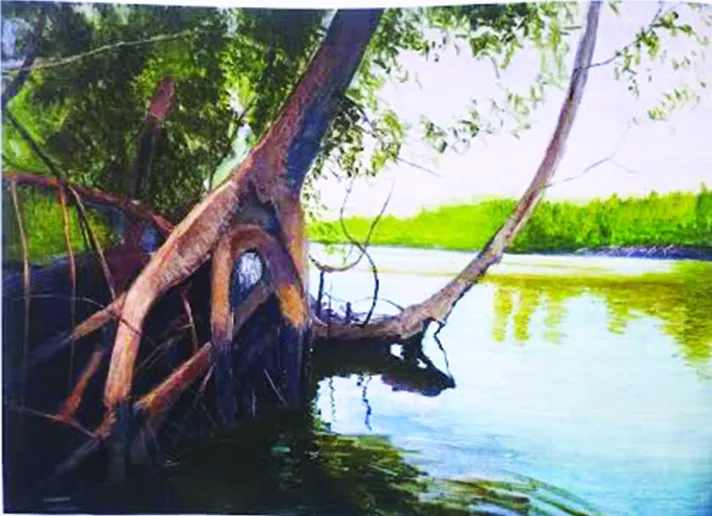 Gbemisola Oluwabusayo
2 months ago
Gbemisola Oluwabusayo
2 months ago
Overview
Mangrove And Art: Exhibition on intersecting the worlds of climate change opens in Lagos
An exhibition of master paintings, drawings and watercolour work of quintessential artist, Dr. John Ed DeBebs, and curated by renowned Oriz U. Onumaje, opened penultimate Wednesday in Lagos, amid palpable excitement.
Hosted by National Gallery of Art (NGA) in collaboration with the National Council on Climate Change and Alizarin Crimson, the exhibition titled “Intersecting the Worlds of Climate Change, The Mangrove And Art”, is an artistic expression and potent instrument that aims to raise awareness, foster emotional connections and inspire action on climate change and its impact on the environment.
While mangroves provide habitat for thousands of species at all levels of marine and forest and are highly efficient in storing carbon, it is imperative that urgent steps are taken to preserve this natural heritage – the mangroves of the Niger Delta.
This is the focus of the ongoing exhibition, holding at West Tower, The Wings Complex, Ozumba Mbadiwe Avenue, Victoria Island, Lagos, which ends on Tuesday, March 18, 2025, and featuring dozens of paintings, including drawings and watercolour, by Dr. DeBebs, as well as 36 of Onumaje’s photographs of the mangrove forests. The photos accompanying quotations offer an inspiring and thought-provoking “poetic echo, a reflection of the painter’s voice.”
Speaking at the formal opening of the exhibition, the Olu of Warri Kingdom, Ogiame Atuwatse III, underscored the significance of the exhibition, noting that “we are gathered not only to appreciate the beauty of artistic expression but to confront an issue that is as immediate and as it is historical: the fate of the Niger Delta mangroves.”
He also noted that for centuries, the people of the Niger Delta have lived with and through the mangroves, adding that “these lands, stretching from the Bight of Bonny to the Bight of Benin, are more than just ecosystems. They are the lungs of our heritage. They sustain our way of life. They protect our shores. They preserve our identity. And yet, while we have looked upon them for generations, others, from far, have begun to look at them differently. Through satellite images, through the lens of economic speculation, and with intentions that threaten the collective sovereignty of the people of the Niger Delta, the world now acknowledges what we have always known: that mangroves are among the most efficient carbon seeds on this planet.
“Unlike the carbon-heavy cities that pollute our atmosphere, these forests absorb and store carbon at an astonishing rate, offering a natural solution to the climate crisis. Yet, while the world praises their value, some seek to slice our lands into invisible pieces, as has been already reiterated in the documentary and the speaker who came before me.”
He also stressed the need to take a stand. “We used to use this moment to mark the first clarion call from our traditional institutions. We, the Itsekiri people and the people of the Niger Delta, will not stand idly by while our mangroves are battered away by foreign interests. We will not allow our heritage to be exploited by those who neither understand its significance nor bear the cost of its destruction. It is time for us, the rightful custodians, to assume responsibility, to protect and protect, to conserve and harness our mangroves for our people and for posterity.
“As we admire the art history before us today, let us recognize that art is not just a reflection of life, but is also a force for change. Dr. John Ed DeBebs has masterfully captured the soul of our mangroves, translating their silent cries onto canvas. Let these works serve as both inspiration and warning.
The time for passive observation is over and the time for decisive action is now. Let us establish a framework to protect our mangroves from exploitation. Let us ensure that any economic benefits derived from them serve our communities first; and let us stand firm in the knowledge that our lands, our heritage and our future is not for sale.
“Every artwork purchased today is more than just a piece of beauty, it is a profound statement of support for the pride to protect and preserve our mangroves.
Source NewTelegraph



